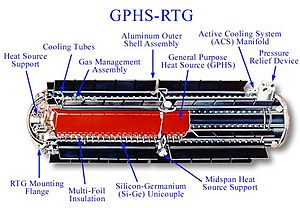Radioisotope thermoelectric generator facts for kids
A radioisotope thermoelectric generator (RTG, RITEG) is an electrical generator that uses an array of thermocouples to convert the heat released by the decay of a suitable radioactive material into electricity by the Seebeck effect. This generator has no moving parts.
RTGs have been used as power sources in satellites, space probes, and uncrewed remote facilities such as a series of lighthouses built by the former Soviet Union inside the Arctic Circle. RTGs are usually the most desirable power source for unmaintained situations that need a few hundred watts (or less) of power for durations too long for fuel cells, batteries, or generators to provide economically, and in places where solar cells are not practical. Safe use of RTGs requires containment of the radioisotopes long after the productive life of the unit. The expense of RTGs tends to limit their use to niche applications in extreme situations.
Images for kids
-
A pellet of 238PuO2 as used in the RTG for the Cassini and Galileo missions. This photo was taken after insulating the pellet under a graphite blanket for several minutes and then removing the blanket. The pellet is glowing red hot because of the heat generated by radioactive decay (primarily α). The initial output is 62 watts.
-
90Sr-powered Soviet RTGs in dilapidated condition.
-
Inspection of Cassini spacecraft RTGs before launch
-
New Horizons in assembly hall
See also
 In Spanish: Generador termoeléctrico de radioisótopos para niños
In Spanish: Generador termoeléctrico de radioisótopos para niños









